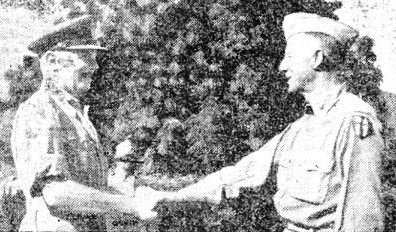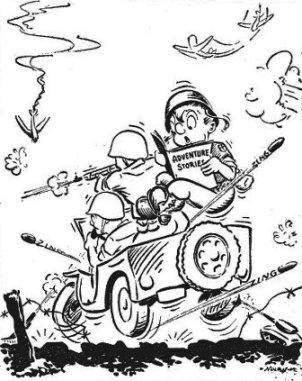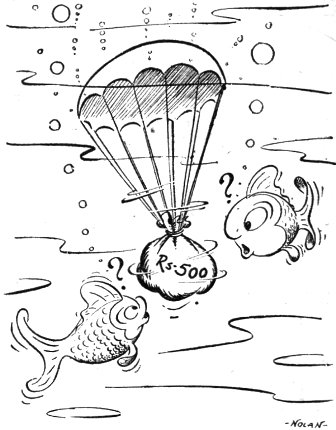
VOL. II NO. 9 REG NO. L5015 DELHI, FRIDAY NOVEMBER 12, 1943.
|
To Protect Ledo Road
Time had grown ripe for Lt. Gen. Sun Li Jen's American-trained and equipped Chinese troops, screening the construction of the Ledo Road, to push farther into Burma. The drenching monsoons had subsided after six months and the spearhead of the lengthening, tortuous supply line being built from India to the Burma Road had wriggled uncomfortably near Jap-held positions in the jungle.
Today the aggressive Chinese are occupying the Hukawng Valley, their northern anchor established at the source of the Chindwin River. The push started Oct. 26 and the first stiffening of Jap resistance came Oct. 31, an eventful day when Lt. Gen. Joseph W. Stilwell, CBI Theater Commander, flew over the area of action in a reconnaissance plane. Hacking at the Jap with machines guns, mortars and cut down Enfield rifles and supported by 10th Air Force bombing and strafing, they had established their superiority in coordinated skirmishes not yet completed.
While Jap reinforcements and supplies are arriving tediously into the area via elephant, raft and motorboat, the Chinese are strengthened daily by supplies parachuted from escorted U.S. transport planes. Brig. Gen. Haydon L. Boatner, Chief of Staff of the Chinese in India. lauded the air droppings as "deserving more credit for the success of the operation than any other single factor."
Jap casualties are reported to be relatively large for the small disposition of troops involved in the close-range, jungle-type fighting that prevails.
Chinese-American Wing In Action With 14th AF
14TH AIR FORCE HQ. - During the past week, the 14th Air Force rained destruction upon Japanese troops, installations, shipping and Japanese-occupied towns. As a result of these missions, during which the newly arrived Chinese-American Composite Wing participated for the first time on November 4, six large enemy vessels were sunk and one more was probably sunk. On a raid against the Swatow Airdrome, three Jap fighters and one bomber on the ground were damaged.
On Nov. 3, B-25's, with fighter escort, made a triple assault against the Jap troops in the Lake Tungting area. Operating in support of Chinese troops, they attacked Ouchihkow, Hwajung and Shihshow. Large fires were started in the target area. Fighter aircraft carrying fragmentation bombs made a successful low-level attack on the Lasion airdrome in central Burma.
The next day B-25's in a shipping sweep over the South China Sea, bombed and sank one 5,900-ton cargo vessel and scored a probable on a 1,000-ton freighter. They also attacked and damaged three Japanese fighters and one bomber which were caught on the ground at the Swatow airdrome. On this mission one plane failed to return.
Two flights of 16 and 21 Jap bombers attacked small towns in Eastern China, but did not cause severe damage.
On Nov. 7, Mitchell bombers with fighter escort returned to the China Coast, hitting shipping in the harbor of Amoy. Coming in at low level, they bombed seven vessels, five of which were left sinking. One of the vessels sunk was a 250-foot Japanese destroyer. The planes encountered heavy fire from anti-aircraft and machine guns but returned safely to their base.
|
Delhi's billeting problem has become so acute that American officers are now advertising in the agony columns of The Statesman. The following gem appeared in a recent issue:
"American officer, former civilian, middle aged, well housebroken, with modulated accent, badly wants one or two rooms of his own (with fireplace, if possible) in which to brood noiselessly over postwar problems after the day's battle. Will consider hotel, flat, bungalow, mansion, chateau, or treehouse, with or without board. Apply Box 9589, Statesman, New Delhi, D605."
Not Necessarily So
WHAT HOMEFOLKS THINK OF C.B.I.
By S/Sgt. ROBERT E. BADGER
CHINA AIR BASE - The ladies on the home front (bless their little hearts!) have the darndest ideas about things.
An officer here recently sent his mother a piece of metal cut from the wing of a Jap bomber that had been shot down nearby.
It would be a nice souvenir, he felt. His fond parent acknowledged receipt of the plane fragment, remarking "Gosh, Son, that bomber was sure knocked into little pieces."
And then, of course, there's the enlisted man who wrote to his wife requesting that she send him a five-pound package containing cigarettes. The little woman answered promptly.
"Darling," she wrote, "I've looked everyplace; I've gone to every store in town, but none of them has cigarettes in five-pound packages; guess I'll have to send you three cartons instead."
We like the reply, too, that a G.I. here in China got in answer to a request he made to his girlfriend back home. He thought it would be nice if she would send him a little Calvert for the Yuletide, fully realizing (the naughty boy) that sending liquor through the mails is strictly against regulations but depending on her good judgment not to advertise the matter.
His hopes were dashed when the cute young thing wrote back as follows: "Darling, as soon as I got your letter I took your request to the Postmaster and, goodness me, did he bawl me out!"
And last of all, there's the officer here who is the proud (?) possessor of five genuine Boy Scout compasses, sent to him by his fond Mama to enable him to find his way around the air base at night.
MORE WACS ARRIVE IN PER DIEM AREA
It's old stuff now, but seven more lovely powder-puff soldiers - WACs to you - have arrived in the Per Diem Hill area of the C.B.I. Theater.
Headed by 2nd Lt. Sally Dean, of Battle Creek, Mich., the feminine invasion force consisted of T/Sgt. Elizabeth Osmer, of Alameda, Calif., T/3 Grace Brock, of Cleveland, Tenn., Sgt. Margaret Brewster, Beatrice, Neb., T/5 Agnes Huth, Brooklyn, T/5 Zona Davis, Chicago, and T/5 Helen Coon, New London, O.
The Roundup has not met the new comrades in arms personally yet - but we intend to. Yes, we intend to.
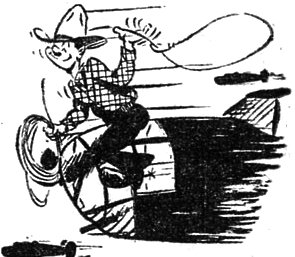
|
BOMBER LASSOES STRANDED SHIP
By Cpl. CHARLES E. BOLTIN
EAST INDIA AIR BASE - Thanks to the ingenuity and courage of members of the "Flying Cobra" squadron, a 10,500-ton Liberty ship and its crew of 77 are riding the waves as a vital link in the bridge over which Allied supplies are now flowing to all parts of the world.
Grounded on the shifting shoals along the coast of the bay of Bengal for several weeks, it appeared as if the vessel would join a graveyard of ships in the vicinity until Lt. Bill Wright and his No. 26 B-24 Liberator bomber went to the rescue.
No. 26, piloted by Wright had already completed 38 missions over Burma when it was selected to do the unique job of helping to rescue a ship. Not only was the undertaking unique, but it was also hazardous. For it was the four-engined bomber's task to zoom in at mast height and lay a 720-foot rope accurately across the deck. Had the rope caught upon an obstruction, it is probable the tail would have been yanked of the B-24.
Several missions were made to lay the rope across the Liberty ship's deck to facilitate the construction of a cable to two tugs which were unable to reach the side of the vessel, over which 22-foot waves were breaking. The initial success by W/O Charles Mitchell had to be repeated when the cable parted under the strain of the laborious tugging of the tiny boats which ultimately dragged the vessel off the treacherous shoals. Mitchell, who has been recommended for the Air Medal, first tried a 4,000-foot length of rope, but was forced to sever it with his jungle knife when it became dangerously snarled.
Some time ago, as reported in the Roundup of October 29, children of the Ashland, Ill., grade school scraped together enough money for a $25 war bond, and sent it to "the commanding general of American troops in China," asking him to paste it on a bomb for Tokyo. In these pictures, we show a bombing raid which carried a bomb dedicated to the kids, not to Tokyo, but close enough to it to bother Mr. Tojo. The motto of the 14th is now, and always has been, "anything for the kiddies." Particularly when that means pasting Japs.
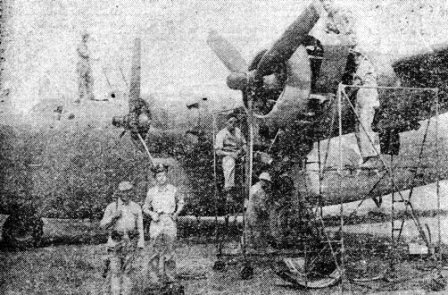 CHECKING UP - T/Sgt. James McGee and Sgts. Purlee, Primosch, Parsons and Kruse, of the ground crew, give the bomb carrying plane the once-over before the raid.
CHECKING UP - T/Sgt. James McGee and Sgts. Purlee, Primosch, Parsons and Kruse, of the ground crew, give the bomb carrying plane the once-over before the raid.
|
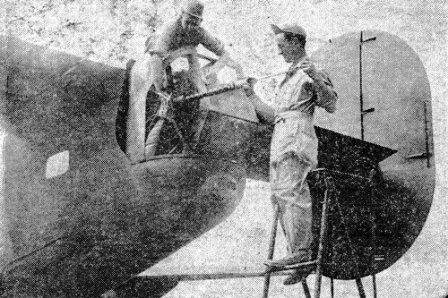 FIRE POWER - McGee again, and S/Sgt. Charles D. Ginn ready the tail gun, just in case the Japs decide they
don't like what they're getting.
FIRE POWER - McGee again, and S/Sgt. Charles D. Ginn ready the tail gun, just in case the Japs decide they
don't like what they're getting.
|
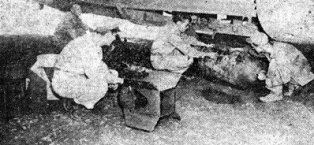 LOADING UP - Sgt. Jack Britton, Lt. John Wahl, M/Sgt. Walter Minnihan, Cpl. Edward Peters and T/Sgt. Robert
Knowling attend to the business end of the bombing raid.
LOADING UP - Sgt. Jack Britton, Lt. John Wahl, M/Sgt. Walter Minnihan, Cpl. Edward Peters and T/Sgt. Robert
Knowling attend to the business end of the bombing raid.
|
 QUEENS RISE PROUDLY - With the grace of a giant bird the big ship takes off for a little call on our buck-toothed friends, with a calling card to leave that the aforesaid friends will be sure to remember. The ground crew says "good luck" and the flight crew takes over.
QUEENS RISE PROUDLY - With the grace of a giant bird the big ship takes off for a little call on our buck-toothed friends, with a calling card to leave that the aforesaid friends will be sure to remember. The ground crew says "good luck" and the flight crew takes over.
|
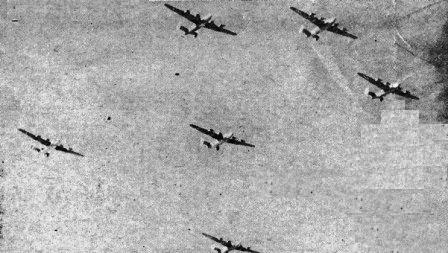 CHINA SKIES - Once the way of the gull and the swallow, China skies today are the highway now of the 14th
Air Force, a high way which leads now only to Jap-occupied cities of China, but which someday will lead straight
to Tokyo.
CHINA SKIES - Once the way of the gull and the swallow, China skies today are the highway now of the 14th
Air Force, a high way which leads now only to Jap-occupied cities of China, but which someday will lead straight
to Tokyo.
|
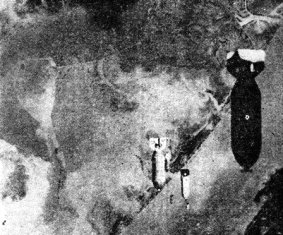 BOMBS AWAY - Down they go, one from Ashland, Ill., and more from every American kid who needs a decent world to grow up in. That's what the 14th is fighting for.
BOMBS AWAY - Down they go, one from Ashland, Ill., and more from every American kid who needs a decent world to grow up in. That's what the 14th is fighting for.
|
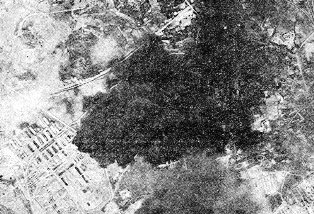 ON THE NOSE - The pilot held his course and the bombardier kept his mind on his business. Results - the bombs hit the target smack on the nose and black clouds billow up from blasted Jap installations.
ON THE NOSE - The pilot held his course and the bombardier kept his mind on his business. Results - the bombs hit the target smack on the nose and black clouds billow up from blasted Jap installations.
|
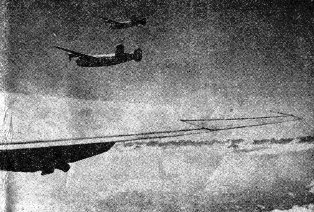 MISSION ACCOMPLISHED - A good day's work done, the giant planes head for the safety, if not the comfort, of
their China home. Cloud formations and a setting sun add peaceful beauty to war's grim work.
MISSION ACCOMPLISHED - A good day's work done, the giant planes head for the safety, if not the comfort, of
their China home. Cloud formations and a setting sun add peaceful beauty to war's grim work.
|
TAKES MORE THAN EARTHQUAKE
 TO WAKE G.I. RIP VAN WINKLE
TO WAKE G.I. RIP VAN WINKLE
By Cpl. J. A. SULLIVAN
SOMEWHERE IN ASSAM - Up until the night of Oct. 23, 1943, Rip Van Winkle was the only nationally-known figure who gained immortality for his ability to sleep. Twenty years was the mark Rip set - admittedly a long time. But old Van Winkle won his horizontal championship in a quiet country glade, with nothing to interrupt his slumber. Also, admittedly, many G.I.'s could equal or better this record, given a quiet country glade and non-interruption.
But here is a new phenomenon. In this corner, at 164 nasal exhilarations a minute, we present T/4 Earl McKeenam, of Council Bluffs, Ia., and sometimes of Omaha, Neb. McKeeman's claim to the sleeping title is brief, but indubitably impressive.
Not only did he sleep on while the ground rumbled and heaved beneath his bed, and the old "shack" shook like the tail man on a conga line, but he continued to saw wood in the ensuing uproar that followed a host of G.I.'s first experience with an earthquake.
Man yelled and words clashed against words:
"I thought it was an air raid," bawled a leather-lunged sergeant.
"I taut de woild was comin' to an end," screamed a Dodger fan.
Added to the fierce vocal nonrestraint was the intermittent sound of bottles of "Fighter Brand" bouncing on the concrete after being impulsively hurled out of various windows. Later, regrets were audible as the throwers learned that it was really a phenomenon of nature and not the discarded brew which caused the rumbling.
On slept McKeeman.
Everywhere men were cornering others to give them their impression of the quake.
"At first I thought it was someone driving a Mack truck through the barracks," was one corporal's story.
Everybody wanted to tell everybody else what they did and what they thought when the earth began to tremble and shake convulsively. But nobody gave two hoots in hell what you thought or what you did. What they did mattered.
And still McKeeman slept on.
Finally, someone discovered Mac. Gad! What an opportunity. Here was someone who hadn't heard anyone's version of the earthquake - and what's more, could not interrupt the speaker with one of his own.
"Hey, Mac, wake up!"
Ah! If it were that simple. But Mac, who had slept through the earthquake, was not to be aroused by anything so refined as the hoarse croak of an hysterical first sergeant's voice.
To conserve space and avoid repetition of "Hey, Mac, wake up!" and the narrating of how men took turns shaking Mac, bouncing the bed and swearing, we must come to the point where Mac finally did wake up.
Whereupon, he berated the noisy hoodlums who had awakened him and, in a soft undertone, invited them to kindly get to hell from out of his room.
And that is why we say McKeeman's claim to the sleeping title is impressive, why we insist that Van Winkle must move over to make room for the new champ.
To what does the champ attribute his success? Says T/4 McKeeman: "I've been in India just about two years now. That's enough to make anybody tired."
OKLAHOMA STATE ORGANIZES CLUB IN C.B.I. THEATER
Some 30 Oklahoma officers and enlisted men in the C.B.I. Theater this week held their first meeting which was highlighted by a talk given by Lt. Charles F. Embree, who was with the 45th Division in the Sicilian operations.
Letters were read from men in the field that could not attend the get-together. A permanent committee was formed in order to plan future meetings, and to keep in contact with all Oklahoma men in the Theater. Capt. A. Cheadle, the master of ceremonies, kept the party in a gay mood - leading songs and serving American beer which had been saved for the occasion.
All men from Oklahoma in the Theater who have not already done so, are requested to write to Capt. Victor O'Neal, Hq., S.O.S., APO 885 (Delhi) in order that they may be informed of any activities of the new club.
DEPARTING FLYERS GREET ARRIVING WACS
WEST INDIA BASE - It was a busy ramp at a West Indian Air Base recently as be-ribboned AAF veterans prepared for departure to that foreign land, the United States. As names were being called and seats
|
Piquant 2nd Lt. Sally Dean, of Battle Creek, Mich., was prevailed upon to be photographed with wearers of the DFC in a "who says the twain can't meet" moment. "What right have we to be photographed with those men who have done so much?" questioned the WAC "dovetail." In answer to which, some wolf on the sidelines murmured, "Hell, they're the heroines. Never before have so few come so far for so many."
Lt. Dean, who escaped from occupied France in 1942, where she had lived abroad for some dozen years, is pictured shaking hands with the erstwhile commanding officer of "The Ringer Bomb Squadron," Maj. Edward M. (Si) Garrett, of Graham, Tex. Others greeting the WACs, ere they sped on their way to the interior, were: Capts. R. L. Aalto, Ray Burkhart, Ray Disher, J. C. German, C. G. Gugino, Lt. G. W. Codu, and S/Sgts. H. J. Everett and G. G. Fraga.
The WACs are T/S Elizabeth Osmer, T/3 Grace Brock, Sgt. Margaret Bewster, and Cpls. Helen Coon, Zona Davis and Agnes Huth.
|
By Pfc. FRED RICHMOND
WEST INDIA BASE - Now it can be told. In recent maneuvers at this base, it was demonstrated again that the Air Corps is not capable of capturing and holding an objective without the aid of ground forces, but the ground forces can perform this operation without aerial support. And to make the matter more pointed, the only members of the ground forces engaged were G.I.'s of the Signal Corps.
At 1830 hours, word reached our headquarters that the Air Corps had accepted an invitation from the ARC to entertain six newly-arrived WACs. We felt we had to do something drastic to uphold the honor of the Signal Corps. Our information further revealed that the Air Corps was to arrive at the WAC emplacement at 2000 hours.
Our strategy, therefore, called for us to launch our attack at 1900 hours. Soon after establishing our bridgehead, and in spite of heavy cross-fire (of questions) from the WACs, we succeeded in convincing them that we were their legitimate dates.
At this critical moment a messenger slipped through our lines, with the information that the WACs were to hold their positions at all costs until the Air Corps arrived. This created a serious threat to our offensive.
Leaving two members of our attacking party to carry out a delaying action, the other two withdrew for a council of war, and it was decided that reinforcements were needed in the form of a member of the ARC to assist us in consolidating the bridgehead. But when our reinforcements arrived, they turned traitor by announcing: "THESE ARE NOT THE BOYS! THEY'RE FROM THE SIGNAL CORPS!" This brought forth a gale of laughter from the WACs, and they seemed well pleased with our raid.
Finally, a compromise was arrived at, and it was agreed that the WACs should spend part of the evening with each, and they arrived at our dayroom for an impromptu dance later in the evening. It was wonderful to dance with American girls again. And the climax of the evening came when the WACs lines us up for drill. They really gave us the works.
We thought we were doing O.K., however, until the WAC sergeant gave the command: "DOUBLE TO THE REAR, TO THE RIGHT FLANK, MARCH!" That stopped us. We thought they were kidding, but they demonstrated how it can be done.
The result: All day long the G.I.'s of this outfit today have been doing one of two things. The saner elements have been talking about a glorious evening had by all. And the Section VIII material of our outfit has been spending spare moments in feverish drill, trying to figure out again howinell it's possible to do a "Double to the rear, To the right flank, March."
Maybe the Signal Corps didn't win, after all. Maybe we'll have to hand the palm of victory, not to the Air Corps, but to the WACs.
Small World
BROTHERS REUNITED BY ACCIDENT IN C.B.I.
By Cpl. CHARLES E. BOLTIN
INDIA ATC BASE - In a war that has already produced some astounding coincidences, here is one that is hard to beat:
Working at a finance window at this base one day not long ago, T/4 Sam J. Natanson was paying out per diem travel allowances to a group of men who had just arrived at the base. When the last man stepped up to the window to get his pay, Sgt. Natanson stared at him, gulped and let out a yell; it was his brother, Pfc. William Natanson, whom he hadn't seen for more than four years, and then way over on the other side of the world!
The happy surprise re-union lasted for a full two months, till William was transferred out to another base in the same theater of operations. Another feature of the co-incidence is that both brothers are assigned to finance work in the Air Transport Command.
OLD FRIENDS MEET IN C.B.I. THEATER
M/Sgt. James E. Griffin of the China-Burma-India Air Service Command had the unusual experience of encountering an old friend from his hometown in an unexpected place.
Griffin, of Bolivar, Tenn., flew to a neighboring air depot on business and discovered the man he was sent to see was Sgt. Jim Emerson, also of Bolivar. Sgts. Emerson and Griffin enlisted in the Army together in October, 1940, and had lost track of each other since.
|
LEDO ROAD MEDICS
 DESERVE CREDIT TOO
DESERVE CREDIT TOO
Dear Sir:
In your recent vivid description of the Ledo Road with Sgt. Lyseczko's excellent picture material, well-deserved credit was given to the road's indefatigable builders. In enumerating the organizations which have contributed to the feat, however, another group of men, who are helping in the successful completion of the vital artery, should be added - the medical soldiers.
Our experiences on the road are probably similar to those of other medical units, which arrived before us. They won't much impress the old-timers in the Theater, as it is the common story. But, for us, it was pretty interesting. We were practically freshly-arrived from the States when we were given this assignment, and we found ourselves faced with a task which was entirely different from what we had been trained for and from our expectations.
We found an area which is still more or less jungle, and instead of nursing patients, the site of the hospital had to be hewn out of bamboo and brush, first. So, we had to change into road workers, our sergeants into foremen, our officers into engineers and supervisors.
We were cutting bamboo, felling trees, handling and splitting logs, building roads, paths and bridges and transforming a mud pile into a livable area. Fighting with mud, leeches and mosquitoes, getting used to the necessarily strict malaria discipline, often with wet feet and the rain diluting the coffee in our canteen cups in the open-air chow line before the mess-basha was finished - such was our daily routine.
In spite of sweating and griping, we were ready at the set date to receive the first patients, thus fulfilling the last order of the day by our Operations Officer: "It may seem impossible, but it will be done."
While part of our men still continue the work of completing the hospital, others have returned to their regular assignments and are now serving those who build the road, to keep and get them well for their important work.
Respectfully yours, Pvt. W. L. Heinman.
'Flying Tiger' In C.B.I. For Second Go At Japs
By Lt. MALCOLM L. ROSHOLT
SOMEWHERE IN INDIA - He can't tell you why he doesn't even try to analyze it himself. But Maj. William N. Reed of Marion. Iowa, is back in the Army Air Corps. And what's more, he's back in Asia waiting to get into action against the Japs - a job left slightly unfinished when flying for the Chinese Air Force with the famed American Volunteer Group, more commonly referred to as the "Flying Tigers."
When the tigers broke up as a fighting unit, a few flyers joined the China Air task Force of the U.S. Army, which has since become the 14th Air Force. A baker's dozen or so have joined forces with the China National
|
It was great being home - particularly since the folks back home insisted on making a hero out of him. After all, it wasn't every small Iowa town that could welcome home a native son who had knocked 11 Zeros and at least that many Mitsubishi bombers out of the China skies as a member of the most fabulous band of sky warriors since Richthofen's Flying Circus. The town threw a banquet for him, attended by the mayor and the governor of Iowa and, as long as he stayed, Reed was a very big shot indeed.
And he enjoyed it. He enjoyed, too, quiet days of fishing for catfish on the Wapsipenicon River and a pheasant hunting trip over the line into South Dakota. He enjoyed meeting old friends and neighbors and schoolmates. After nerve-wracking days of gambling with death in the skies, it was great to be at home, and at peace.
But it didn't last. Things were going on in the world, and down in his heart, Reed knew that he had a part to play in them. Spending a few weeks traveling with Jinx Falkenburg and the Ritz Brothers on a war bond tour wasn't enough. So he applied for reinstatement in the U.S. Army Air Corps. And on Jan. 4, 1943, he was a second lieutenant, the same rank he held when he finished at Randolph and Kelly Fields in October 1940.
But the Army knew a good thing then it saw one, and only 24 days after pinning on those shiny gold bars Reed was replacing them with golden oak leaves. he had been jumped straight from shavetail to major, with no pause whatever at first lieutenant or captain. "And immediately," he remarked, "my voice took on a deeper bass and a more authoritative tone."
Now he's back in the China-Burma-India Theater, attached to one of the Operational Training Units recently set up by Maj. Gen. George E. Stratemeyer, and is a squadron commander within the Chinese-American Composite Wing of the Chinese Air Force - an organization which is expected to play a big role in the skies of China in months to come. This means he is on loan, at present, to the Chinese Air Force but is still a member of the U.S. Army Air Corps.
CHOSEN TO GO BACK TO SHANGRI-LA
|
EAST INDIA BASE - Sometimes dreams do come true, sometimes. At least, that's the way 10 lucky members of a Liberator formation here feel, for they've just been told that they're on their way back to Shangri-La. And they'll fly back in a plane which has won the respect and affection of everyone at the base, "Old 26," the Rangoon Rambler.
The deal came up because back home they want to show the bond-buying public a bomber with combat history and some real flesh-and-blood "heroes" during the next bond-selling drive. Soon "26," which has been on considerably over 50 bombing missions, was the plane selected, and a crew was formed for the trip with members chosen largely for their length of service and combat flying hours.
Those who will return are: Capt. Raymond C. Rote, 23, of Phoenix, Ariz., who has 393 combat hours and wears the Air Medal and Distinguished Flying Cross; Capt. Gordon H. Wilson, 26, of Whitesburg, Ky., with 320 combat hours and the Air Medal and Distinguished Flying Cross; 1st Lt. Robert P. Currie, 28, Big Springs, Tex., 437 combat hours and the Air Medal and DFC; 1st Lt. Guy H. Spotts, 24, Williamsport, Pa., 377 hours with Air Medal, DFC, with Oak Leaf Clusters for both, the Silver Star and the Purple Heart; T/Sgt. Adolph Scolavino, 23, Providence, R.I., 377 hours, Air Medal with Oak Leaf Cluster and DFC; T/Sgt. Ferdinand Knetchel, 22, Ellword City, Pa., DFC and Air Medal with Oak Leaf Cluster, 407 hours; S/Sgt. John E. Craigie, 26, West Haven, Conn., DFC and Air Medal with Oak Leaf Cluster, 379 hours; S/Sgt. Edward M. Salley, Houston, Tex., DFC and Air Medal with Oak Leaf Cluster, 379 hours; S/Sgt. Carl E. Paak, 21, Antigo, Wis., 386 hours, Air Medal with Oak Leaf Cluster and DFC, and S/Sgt. Joseph E. Willis, 21, Augusta, Ark., Air Medal with Oak Leaf Cluster and DFC, 375 hours.
The average of the group is more than378 combat hours, which shows that its members have not been idle since coming to the C.B.I. Theater and now deserve a rest. The plane, in addition to other sorties, has flown on two of the longest missions of the war in any Theater, 2,700 miles in two raids on Bangkok and more than 2,000 miles over water in two more raids on Car Nicobar Island.
Eric Sevareid, CBS News commentator, who was one of the parachute party rescued recently after their plane crashed in the jungles, also will be aboard when the plane takes off for the States.
|
Lives Of Supply Unit
By Pfc. JACK J. MISENHELDER
INDIA SUPPLY BASE - The India sun seemed to shine a little brighter and the grass somehow seemed greener here this week, as members of this supply squadron saw some long-awaited good news posted on the bulletin board. You guessed it - PROMOTIONS!
Excitement had been running high for days, as rumors of the coming ratings circulated. "Bucking" was very much in evidence, proved by hurried trips to the barber-wallah by shaggy-haired individuals, daily shaves and deeper respect for high-ranking non-coms. Pfc. Charles W. Frazier, of Premium, Ky., was even observed singing in his sleep. When asked why by Pvt. Frank Merrill, in the next bunk, the Kentuckian replied in a sleep-groggy voice: "I want to let 'em know I'm around when all those ratings are passed out."
10TH AIR FORCE CONTINUES
 STEADY POUNDING OF BURMA
STEADY POUNDING OF BURMA
Liberators, Mitchells, and fighter-bombers of the 10th U.S. Air Force intensified their activity over enemy airdromes this week in forays over north-central Burma. Supply centers, highway and railway bridges and enemy-occupied buildings were among the many other targets pounded during the seven-day period. All of our planes returned safely to their bases.
On Nov. 2, Liberators pounded Kalewa, Ye-U and Monywa. At Kalewa, on the Upper Chindwin, several direct hits on an enemy occupied building caused a large explosion. Another formation bombed Hkonthon, five miles south of Kalewa. Incendiary bombs were showered on buildings in the vicinity of the railway tracks and rail terminus at Ye-U. Large fires were started and smoke, which rose to 5,000 feet, was visible for 80 miles. Railroad yards at Monywa, Ywataung and Padu were bombed and trackage and rolling stock were heavily damaged. Fighter-bombers also had a busy day bombing and strafing a number of targets in northern Burma. The Loilaw railroad bridge, between Manywet and Mogaung, was completely knocked out. Enemy positions were strafed on the road to Sumprabum, fires were started by strafing at Sahmaw and large buildings were demolished at Alam, 12 miles north of Myitkyina.
SWEBO HIT
On November 3, the landing ground at Swebo was attacked by Mitchells with bombs bursting along the entire length of the runway and nearby revetments. Liberators blasted the runway and nearby revetments. Liberators blasted the runway intersection at Loiwing airdrome, 35 miles southeast of Bhamo in north-central Burma, and tore up the runway on either side of the intersection. Heavy damage was caused at the Myitkyina landing grounds by fighter-bombers. Direct hits were scored on each runway, enemy planes were strafed and a fuel truck exploded.
Fighter-bombers continued to pound and strafe enemy installations in northern Burma on November 4. Many objectives were hit in the Hukawng Valley and fires
|
Akyab was attacked on November 5 by Liberators and Mitchells. More than 50 tons of demolition and incendiary bombs were dropped in the area. From a hit in the vicinity of the main jetty a column of smoke rose to 2,000 feet and was visible for 70 miles.
Namma, a railroad town and enemy supply center was the target for fighter-bombers on November 6. Fires were left burning in the railroad switch yards, and a direct hit on a large building resulted in an explosion followed by billows of reddish-orange smoke. Warehouses were set ablaze on each side of the railroad and a large fire was started at the south end of the town. Other formations successfully hit the Maingkwan-Walawbum area.
FIGHTERS ACTIVE
On November 7, fighter-bombers left several locomotives enveloped in steam on the railroad between Naba and Mogaung. At Indaw, warehouses received direct hits which resulted in a violent explosion. The water tower at Mohnyin was strafed and rolling stock at Sahmaw was damaged. In a sweep from Kamaing to Walawbum, another formation destroyed many buildings in the Shadazup area, and the main runway at the Bhamo landing ground was torn up by direct hits.
The railways at Paleik, 10 miles south of Mandalay, were attacked on November 8 by Mitchells. Bombs fell in the center of the yards, demolishing rolling stock and causing an oil or gasoline explosion. Fighter-bombers attacked the landing ground at Myitkyina, scoring many direct hits on the runway, and fires were left burning in the barracks area. Other towns attacked were Mainga, Shadazup and Langan Ga in the Hukawng Valley.
LUCK RIDES BURMA SKIES
FLYING COBRAS CHEAT DEATH
By Lt. GEORGE L. BUTT
EAST INDIA AIR BASE - Members of this history-making "Flying Cobra" squadron were talking without instruments at the Officers Club last night, contesting the fitful playing of the piano and the click-click of the ping-pong table. And the conversation drifted to narrow escapes.
The "Flying Cobras" have been thundering over Burma with B-24 Liberator bombers since late last November, after fighting the Japs from Java and the Eyeties and Nazis from bases in the Middle East. There have been numerous instances where Lady Luck smiled when, had she frowned, the War Department would have wired its condolences to families at home.
It is a miracle that Lt. James R. Barton and his crew of the Arabian Nights were among those able to be around to relate their experiences last night. The other day, six Zeros jumped the Arabian Nights after it helped bomb Heho, 70 miles southeast of Mandalay. The Nips were shaken off, but en route home S/Sgt. Henry Spiek, the waist gunner, smelled burning rubber. Diagnosis was that the gas tanks were afire. Barton nursed the B-24 into Chittagong and discovered upon landing that an incendiary bullet had set a blaze which completely consumed two gas cells. That the tanks didn't explode was miraculous. Additionally, there were only 15 gallons of gasoline remaining which meant that the big ship wouldn't have been able to make the field if it had over-shot its mark on the first attempt.
WASN'T FIRST TIME
Last March, Barton had to make another emergency landing at Chittagong. The target on this occasion was Pyinmama, 70 miles north of Toungoo. Barton's Lone Wolf was badly chewed by enemy fighters. The top and tail turrets were put out of commission, the tail assembly badly damaged and an engine silenced. S/Sgt. Verl Johnson had the microphone shot off his neck, too, but was untouched.
The British have a right to complain of Barton abusing their hospitality, for on both occasions Jap bombers followed immediately by striking at Chittagong.
Sgt. Lawrence D. Rademacher, a top turret gunner, has no right to complain of his luck. Four times death breathed coldly upon his neck and he cheated it. Recently a Zero bullet left a red crease across his forehead. Early this year, he was shot in the stomach, but was up and around not long later, Then, during successive raids over Rangoon, he was spotlighted in one of the most unique coincidences in aerial combat history. On the first, he received a scratch on the cheek from ack-ack, on the second, another ack-ack burst tore the bandage off the wound.
FOUR-LEAF CLOVER?
The pilot of Rademacher's plane, burly, gum-chewing Capt. Gordon H. Wilson, has often been accused also of toting a four-leaf clover in his hip pocket. No less than 15 times has he brought back his B-24 riddled with enemy fire. But the point is, he brought it back.
Not long ago, a visiting fireman joined a mission into Burma. He was Lt. Col. Bertram Harrison, now en route to the States. When he leaned over to check the instruments in his role as co-pilot, a 20 mm explosive shell tore through the windshield and plowed into the back of the seat exactly where he had been sitting.
Two engines that died, then came to life at the ninth-minute gave Lt. William T. Larkin and his crew a ticklish time during a mission that took them far out over the Bay of Bengal. They were flying at 800 feet indicated, with a solid overcast immediately overhead, when two engines cut out simultaneously. Heavily loaded with bombs and gasoline, there was only one way for the plane to go. That was D-O-W-N, Larkin; Lt. Douglas M. Lowe, co-pilot; and T/Sgt. Louis L. Russell, engineer, couldn't find any apparent reason during their frantic search why the engines should not function. Meanwhile, the altimeter registered 300 feet and the ship was on the verge of losing air speed. Then, suddenly, both motors throbbed into new life.
PRAISE GROUND CREWS
Combat member of the "Flying Cobras" are quick to praise their ground crews for helping the squadron make history from its base in Eastern India. The ground echelon sailed for "destination unknown" on Nov. 21, 1941, and were on the high seas the day Pearl Harbor was struck. It then proceeded to Australia via the Fiji Islands, where it assembled P-40's and B-24's. The unit arrived in India during February of last year. Don't, please, try to argue with the "Flying Cobras" that there are better line crews in the Army Air Force. You'll get lumps on your head for the trouble.
First squadron to leave the States after the war began, the "Flying Cobras" proceeded to Java on Dec. 28, 1941, flying B-17's. There as part of the 19th Group, it played a considerable part in inscribing the 19th's feats in the history books. After Java fell, a few of the flight echelon moved to India, keeping the squadron's identity on the insistence of Col. Conrad Necrason, Its CO, who is now group commander.
LONGEST RAIDS OF WAR
During the early stages of operations against Burma by the "Flying Cobras," some of the longest raids of the war were made from deep within India to Bangkok. These perilous flights were made last December. During that month, missions averaged 2,222 statute miles. The prior three months - August, September and November - the squadron operated in the Middle East against the Germans and Italians, bombing convoys and striking blows against Tobruk, Benghazi, Candia and other targets.
A glance at the records helps tell the story of the "Flying Cobras" length of continuous service. Forty-four men have piled up 40 missions or more, nine of them more than 45. All are still on combat crews. It's a grand tribute to a glorious squadron.
|
PAYMASTERS HAVE TOUGH JOB IN C.B.I.
A two-engined cargo plane is flying low over the jungles of Burma. A motor starts to sputter, and then finally cuts out entirely. The pilot shouts back to the crew to throw out the cargo to lighten the ship so it can keep up on one motor. One by one the sacks and baskets filled with precious air-dropping cargo go winging their way toward the earth. The crew groans as one sack that is heavier than the rest goes out of the door and heads straight for a lake. It is a sack of silver rupees.
It is incidents like this that make the job of the Finance Department of the Services of Supply of the United States Army Forces in China, Burma and India more colorful than a routine banking job at a desk in Wall Street. In areas like Assam, up near the Burma Frontier, there is nothing routine about an Army Finance job.
Banking facilities are of course limited in the area, but through the co-operation of the government of the Province of Assam, the facilities of the various sub-treasuries are made available to the Finance Department in securing funds. These arrangement were made by the Headquarters of the Services of Supply with the government of the province of Assam and eliminate the necessity for long overland trips to the bank with consequent saving of time and transportation.
PILES OF DOUGH
At the end of each month in Assam, untold lakhs of rupees are drawn from sub-treasuries of the Government of Assam. Stack after stack of one hundred rupee notes, ten rupee notes, five rupee notes and one rupee notes are paid for at the sub-treasury by a check drawn on the Imperial Bank of India. bags of eight anna, four anna, two anna, and one anna pieces are picked up.
Some of this money goes to the men and officers of the base in which the finance office operates, but the greater part of it goes up the new road which is being built into Burma and is used to pay the soldiers and native laborers who are toiling on the road or even further out in advanced bases in the jungle. Company commanders acting as agent finance officers draw the money at the Finance Office and it goes up into the wilds to pay the men who are running the lead bull-dozer and the men who are laying a rock foundation for the road or building bridges which will stand the ravages of next year's monsoon.
Some of the money goes far back into the jungle to the advance survey parties. Officers strap it to their backs in packs and start long treks, which may take them several weeks, to pay off men who are far away from the ordinary lines of supply.
SOME AIR-DROPPED
Some of the money is carefully packaged and air-dropped to units which cannot be reached over the jungle trails. It was on one of these missions that the bag of silver rupees was lost. This was the only money lost in countless air-dropping missions of this sort, and fortunately the bag contained only five hundred silver rupees and was actually worth much less than other types of cargo which were jettisoned to keep the plane in the air.
The C.B.I. Roundup is a weekly newspaper published by and for the men of the United States Army Forces in China, Burma, and India, from news and pictures supplied by staff members, soldier correspondents, the United Press, and the War Department. The Roundup is published Friday of each week and is printed by The Statesman in New Delhi, India. Editorial matter should be sent directly to Lt. Floyd Walter, Rear Echelon Hq., U.S.A.F., C.B.I., New Delhi, and should arrive not later than Monday in order to make that week's issue. Pictures must arrive by Sunday and must be negatives or enlargements. Stories should contain full name and organization of sender.

NOVEMBER 12, 1943
Original issue of C.B.I. Roundup shared by Ruth Canney, widow of CBI veteran John Canney.
Copyright © 2007 Carl Warren Weidenburner
THE RANGOON RAMBLER
TOP OF PAGE PRINT THIS PAGE ABOUT THIS PAGE SEND COMMENTS
PREVIOUS ISSUE CLOSE THIS WINDOW NEXT ISSUE
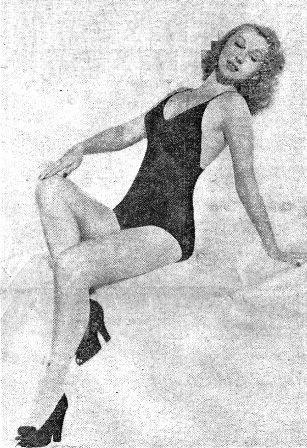
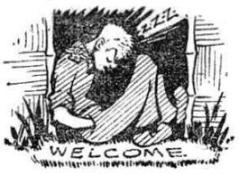
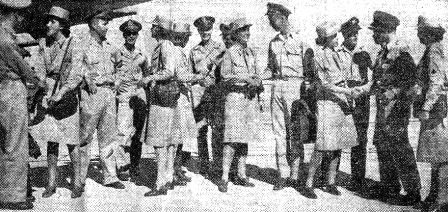
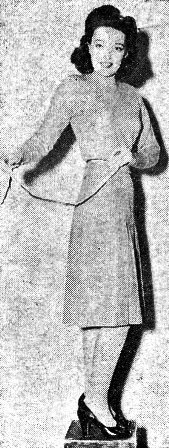
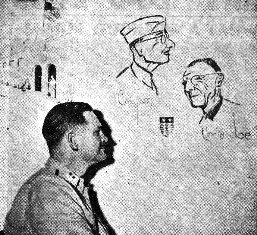
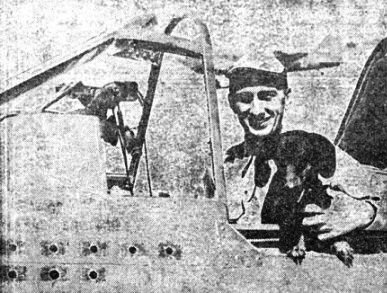
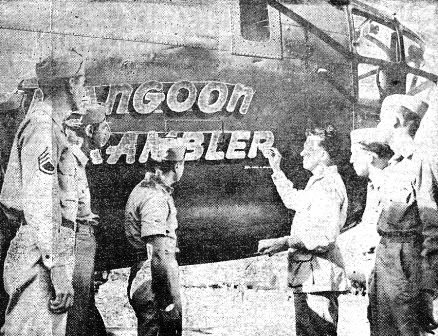 Just as Minnie Spiewack changes her name to Fleurette La Rue when she goes to Hollywood, this plane, known during
its combat days merely as "Old 26," acquires a fancy cognomen for its bond-selling tour of the States. T/Sgt.
Scolavino does a neat job of christening the ship "Rangoon Rambler," while the crew looks on with a distinctly
"so what?" attitude.
Just as Minnie Spiewack changes her name to Fleurette La Rue when she goes to Hollywood, this plane, known during
its combat days merely as "Old 26," acquires a fancy cognomen for its bond-selling tour of the States. T/Sgt.
Scolavino does a neat job of christening the ship "Rangoon Rambler," while the crew looks on with a distinctly
"so what?" attitude.
